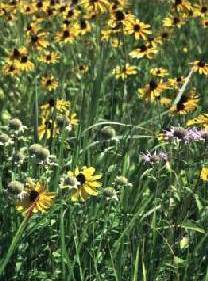

ABSTRACT:This laboratory activity is designed to teach upper-level students in a plant ecology course how to collect data on plant
populations (distribution and abundance), formulate hypotheses to explain observed patterns, and write a research proposal to test their
hypotheses. This is a semester long project requiring 13 * 2 ¾ hour lab classes. Motivation for hypothesis generation is a planted plot
populated by seeded and volunteer plants. Students, working in groups of 2 or 3, make qualitative observations, collect plant distribution
data, collect and analyze abiotic variable data, propose and research questions, and propose a series of experiments to answer these
questions. All proposed hypotheses must be based upon the qualitative and quantitative observations made by the students. Hypotheses
are generated by the student groups, reviewed by the instructor, and mutually agreed upon, after revisions, by students and instructor.
Students individually prepare a written proposal and also present details of their proposals in small-research groups. AUTHOR:Alan B. Griffith Department of Biological Sciences, University of Mary Washington, ___________________________________________ CLASS TIME:13 weeks, with 2 hour and 45 minute classes per week OUTSIDE OF CLASS TIME:20 hours - Students spend out of class time creating data presentations (i.e. graphs and tables), researching and reading the
literature related to their hypotheses, designing and collaborating on 2 oral presentations, designing and describing appropriate experimental
designs, writing an annotated bibliography, and writing a final research proposal. STUDENT PRODUCTS:The major assessment for students is a research proposal, presented orally and in writing, designed to answer 4 specific
hypotheses / questions about the abundance and distribution of plants. Students produce components of this proposal as the semester
progresses, and present the full proposal at semester’s end. The progressive “creation” of the full proposal gives students the opportunity
for feedback from the instructor in order to improve their work. Most of the student work for this experiment is a collaboration of 2 or 3
students in a research group. Students can analyze data together, design data presentations together, and collaborate on experimental
designs. Student products are a combination of individually graded and group graded products. All written assignments are graded
individually and therefore must be written by each student. For example, the appearance of graphs and/or tables can be developed as
a group. But, the title / captions for these data presentations must be written individually for grading. Both oral presentations are given
by the research group. SETTING:
Field work is done in a prepared experimental garden measuring 2 m X 30 m. The experimental garden is used by 2 different laboratory
sections, so the use of destructive sampling techniques is limited. Lab work will typically be required to prepare and analyze abiotic
samples such as soil samples for soil moistures and soil texture. Students will also require access to computer facilities. See
“Overview of Data Collection and Analysis Methods” below for more details on typical data collected and lab analyses.
COURSE CONTEXT:This class is the required laboratory for a junior /senior level plant ecology course. I teach 2 sections of this laboratory
with 16 students in each section. The course syllabus gives further details
(Appendix1_syllabus_fall2003.doc, 36k). INSTITUTION:University of Mary Washington is a Virginia state liberal arts university. TRANSFERABILITY:This experiment will transfer well to any scale college or university, as equipment needs are flexible. The activities and goals
could be easily changed to fit a quarter system schedule. I see this mostly as an upper division course, given its duration. It would be possible
to excerpt components of this experiment for use in lower level laboratories. For example, one might use 2 - 3 laboratory periods to collect
qualitative and quantitative data on field plots to motivate hypothesis generation by students about the abundance and distribution of plants in
nature. This would be a worthwhile field experience where students use potentially messy data to generate clear measurable hypotheses. I
do believe this format may lend itself to a year long biology or environmental science group project for high school students. ACKNOWLEDGMENTS:
The fundamental elements of this experimental proposal were formulated while acting as teaching assistant for Dr. Irv Forseth, University of Maryland.
Over the course of several years teaching his plant ecology lab, he and his teaching assistants designed and created a laboratory course that relied
more and more on extended greenhouse experiments of plant competition and soil heterogeneity. Two friends and colleagues, Dr. Andrew McElrone
and Dr. Michael Peek organized and formulated these laboratories at the University of Maryland. Although we had few details, we also knew that Dr.
Brenda Casper, University of Pennsylvania, conducted a plant ecology lab consisting solely of an extended experiment of the students’ design.
This submission has benefited from comments by TIEE Editors and an anonymous reviewer. CITATION:Griffith, A. B. August 2004, posting date. Inquiry-based Learning in Plant Ecology: Students Collect the Field Data, Ask the Questions, and Propose the Answers. Teaching Issues and Experiments in Ecology, Vol. 2: Experiment #2 [online]. http://tiee.ecoed.net/vol/v2/experiments/proposal/abstract.html |

floral diversity in the U MW experimental plot, © Alan B. Griffith,
full size image
|
<top> | |